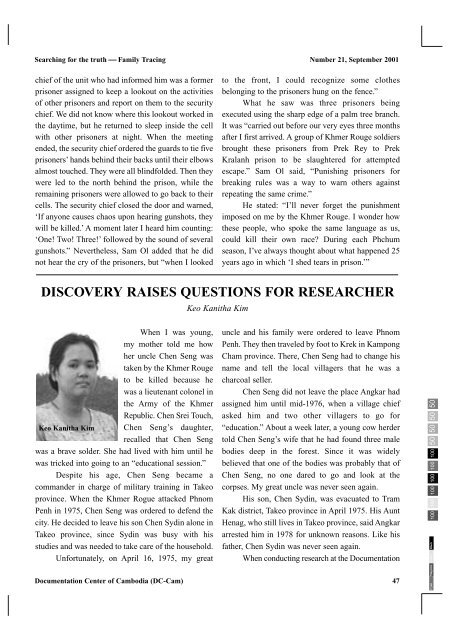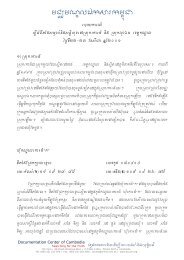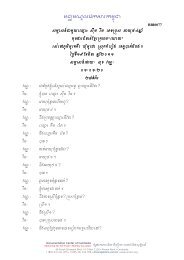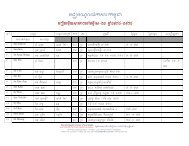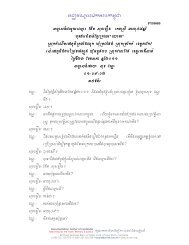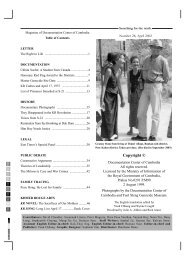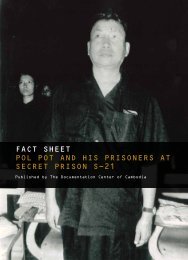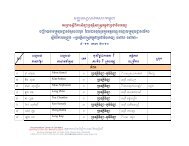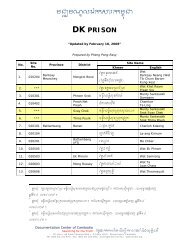Searching for the truth Issues 21 - Documentation Center of Cambodia
Searching for the truth Issues 21 - Documentation Center of Cambodia
Searching for the truth Issues 21 - Documentation Center of Cambodia
You also want an ePaper? Increase the reach of your titles
YUMPU automatically turns print PDFs into web optimized ePapers that Google loves.
<strong>Searching</strong> <strong>for</strong> <strong>the</strong> <strong>truth</strong> ⎯ Family Tracing<br />
chief <strong>of</strong> <strong>the</strong> unit who had in<strong>for</strong>med him was a <strong>for</strong>mer<br />
prisoner assigned to keep a lookout on <strong>the</strong> activities<br />
<strong>of</strong> o<strong>the</strong>r prisoners and report on <strong>the</strong>m to <strong>the</strong> security<br />
chief. We did not know where this lookout worked in<br />
<strong>the</strong> daytime, but he returned to sleep inside <strong>the</strong> cell<br />
with o<strong>the</strong>r prisoners at night. When <strong>the</strong> meeting<br />
ended, <strong>the</strong> security chief ordered <strong>the</strong> guards to tie five<br />
prisoners’ hands behind <strong>the</strong>ir backs until <strong>the</strong>ir elbows<br />
almost touched. They were all blindfolded. Then <strong>the</strong>y<br />
were led to <strong>the</strong> north behind <strong>the</strong> prison, while <strong>the</strong><br />
remaining prisoners were allowed to go back to <strong>the</strong>ir<br />
cells. The security chief closed <strong>the</strong> door and warned,<br />
‘If anyone causes chaos upon hearing gunshots, <strong>the</strong>y<br />
will be killed.’ A moment later I heard him counting:<br />
‘One! Two! Three!’ followed by <strong>the</strong> sound <strong>of</strong> several<br />
gunshots.” Never<strong>the</strong>less, Sam Ol added that he did<br />
not hear <strong>the</strong> cry <strong>of</strong> <strong>the</strong> prisoners, but “when I looked<br />
<strong>Documentation</strong> <strong>Center</strong> <strong>of</strong> <strong>Cambodia</strong> (DC-Cam)<br />
Number <strong>21</strong>, September 2001<br />
to <strong>the</strong> front, I could recognize some clo<strong>the</strong>s<br />
belonging to <strong>the</strong> prisoners hung on <strong>the</strong> fence.”<br />
What he saw was three prisoners being<br />
executed using <strong>the</strong> sharp edge <strong>of</strong> a palm tree branch.<br />
It was “carried out be<strong>for</strong>e our very eyes three months<br />
after I first arrived. A group <strong>of</strong> Khmer Rouge soldiers<br />
brought <strong>the</strong>se prisoners from Prek Rey to Prek<br />
Kralanh prison to be slaughtered <strong>for</strong> attempted<br />
escape.” Sam Ol said, “Punishing prisoners <strong>for</strong><br />
breaking rules was a way to warn o<strong>the</strong>rs against<br />
repeating <strong>the</strong> same crime.”<br />
He stated: “I’ll never <strong>for</strong>get <strong>the</strong> punishment<br />
imposed on me by <strong>the</strong> Khmer Rouge. I wonder how<br />
<strong>the</strong>se people, who spoke <strong>the</strong> same language as us,<br />
could kill <strong>the</strong>ir own race? During each Phchum<br />
season, I’ve always thought about what happened 25<br />
years ago in which ‘I shed tears in prison.’”<br />
DISCOVERY RAISES QUESTIONS FOR RESEARCHER<br />
When I was young,<br />
my mo<strong>the</strong>r told me how<br />
her uncle Chen Seng was<br />
taken by <strong>the</strong> Khmer Rouge<br />
to be killed because he<br />
was a lieutenant colonel in<br />
<strong>the</strong> Army <strong>of</strong> <strong>the</strong> Khmer<br />
Republic. Chen Srei Touch,<br />
Keo Kanitha Kim<br />
Chen Seng’s daughter,<br />
recalled that Chen Seng<br />
was a brave solder. She had lived with him until he<br />
was tricked into going to an “educational session.”<br />
Despite his age, Chen Seng became a<br />
commander in charge <strong>of</strong> military training in Takeo<br />
province. When <strong>the</strong> Khmer Rogue attacked Phnom<br />
Penh in 1975, Chen Seng was ordered to defend <strong>the</strong><br />
city. He decided to leave his son Chen Sydin alone in<br />
Takeo province, since Sydin was busy with his<br />
studies and was needed to take care <strong>of</strong> <strong>the</strong> household.<br />
Un<strong>for</strong>tunately, on April 16, 1975, my great<br />
Keo Kanitha Kim<br />
uncle and his family were ordered to leave Phnom<br />
Penh. They <strong>the</strong>n traveled by foot to Krek in Kampong<br />
Cham province. There, Chen Seng had to change his<br />
name and tell <strong>the</strong> local villagers that he was a<br />
charcoal seller.<br />
Chen Seng did not leave <strong>the</strong> place Angkar had<br />
assigned him until mid-1976, when a village chief<br />
asked him and two o<strong>the</strong>r villagers to go <strong>for</strong><br />
“education.” About a week later, a young cow herder<br />
told Chen Seng’s wife that he had found three male<br />
bodies deep in <strong>the</strong> <strong>for</strong>est. Since it was widely<br />
believed that one <strong>of</strong> <strong>the</strong> bodies was probably that <strong>of</strong><br />
Chen Seng, no one dared to go and look at <strong>the</strong><br />
corpses. My great uncle was never seen again.<br />
His son, Chen Sydin, was evacuated to Tram<br />
Kak district, Takeo province in April 1975. His Aunt<br />
Henag, who still lives in Takeo province, said Angkar<br />
arrested him in 1978 <strong>for</strong> unknown reasons. Like his<br />
fa<strong>the</strong>r, Chen Sydin was never seen again.<br />
When conducting research at <strong>the</strong> <strong>Documentation</strong><br />
47<br />
100 100 100 100 100 100 50 50 50 50<br />
Black<br />
Yellow<br />
Magenta<br />
Cyan


